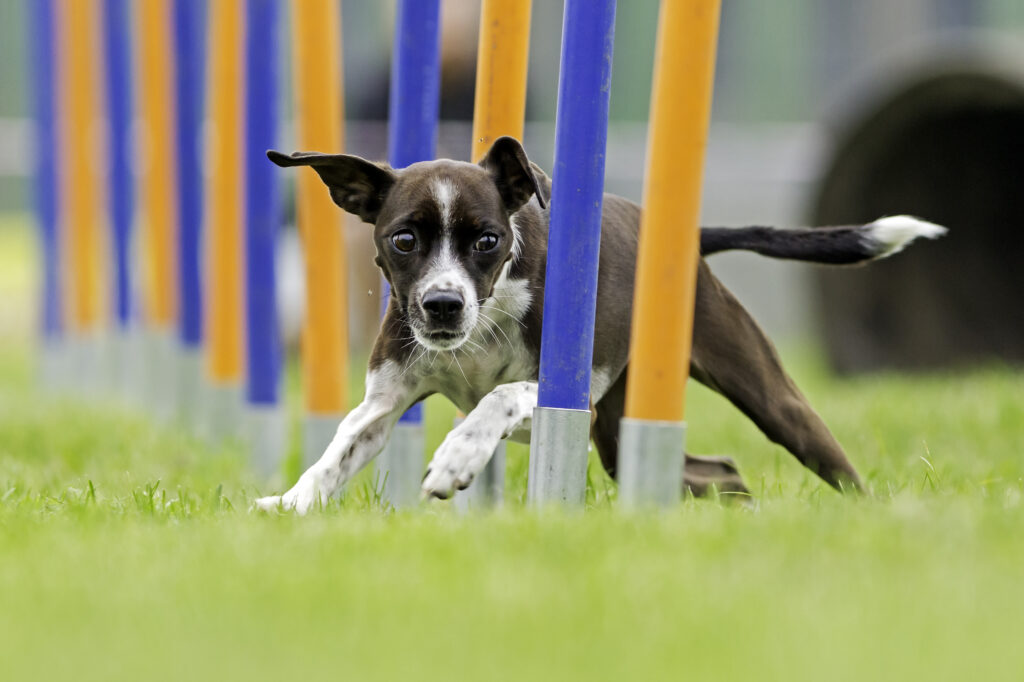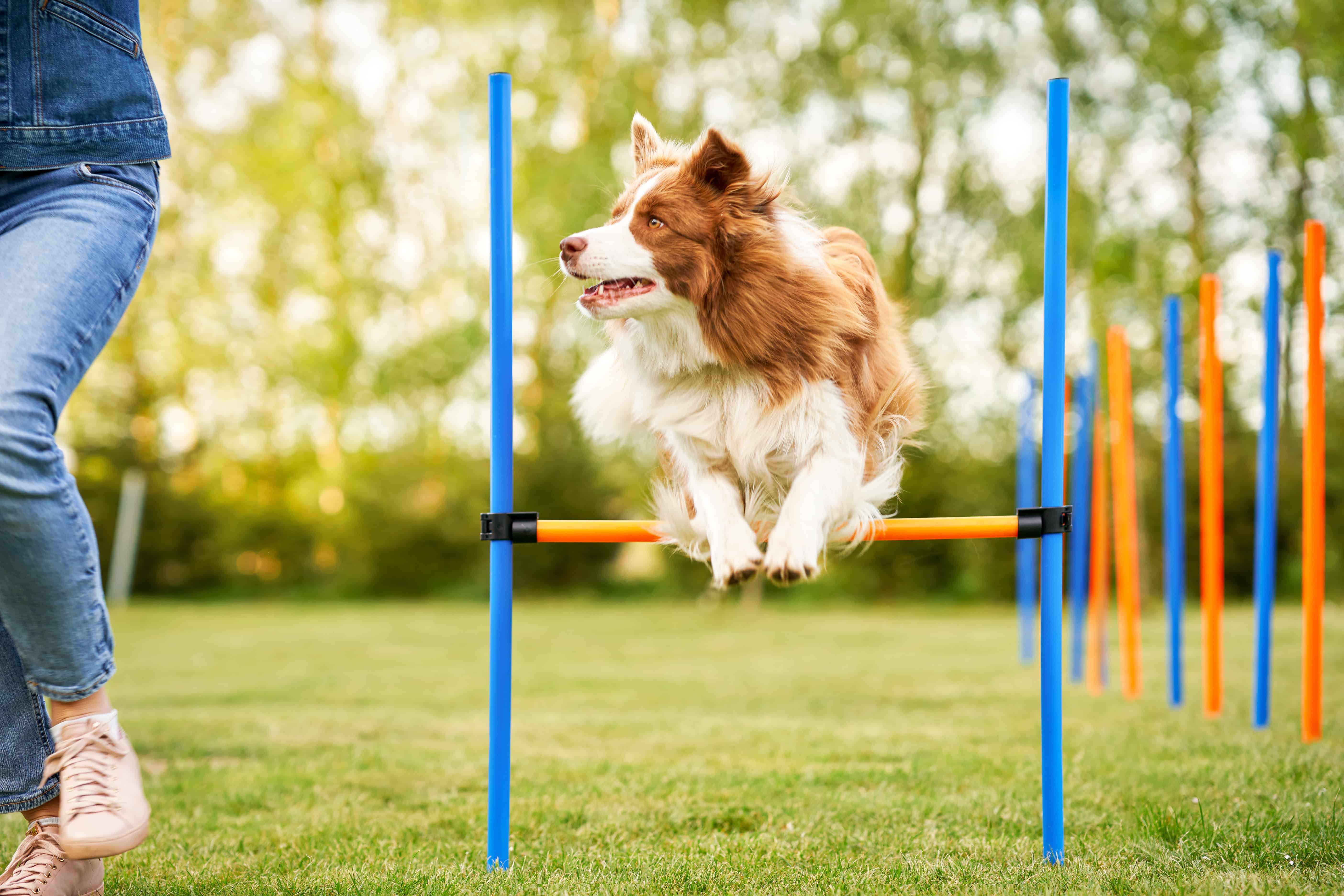If you’re active in any online dog community, it is likely that you have seen a clip of a dog enthusiastically weaving their way through an agility course. Exhilarating and exciting, the agility dogs who make it to such a high level are like finely-tuned athletes – completing the course in a mixture of grace and haste.
As a dog owner, you may think that it isn’t possible for your own pet dog to reach the high levels of competitive agility dogs. While attaining that standard is a tough ask for the average human-dog team, it doesn’t mean that you and your pup can’t experience the thrill of taking part in agility training yourselves! Agility training offers many benefits for dogs and humans alike.
In this article, we’ll look at which dogs are best suited for agility training, and outline some of the benefits of taking part in this exciting dog sport.
Which dogs are best suited for agility training?
The nature of agility training harnesses a dog’s inherent abilities for sprinting, chasing and hunting. However, these abilities must be nurtured as part of the training process – so ideally, a trainable dog with a good working temperament is the best choice. Additionally, it is important to ensure that the dog is physically capable of completing the course. This is why small-to-medium sized dogs are more adept at agility.
Bearing these factors in mind, some of the breeds best suited for agility training include:
- Border Collies
- Golden Retrievers
- Australian Shepherds
- Belgian Sheepdogs
- Papillons
- Pembroke Welsh Corgis
- Australian Kelpies
Finally, it is important to note that agility training is not suitable for every dog. Dogs meeting any of the following criteria should not take part in agility training:
- Young puppies – Their joints, bones and muscles are still growing, and large jumps or twisting motions could result in injury and harm their future development.
- Senior dogs – Older dogs may have brittle or fragile bones, and could be more susceptible to injuries on the agility course.
- Dogs rehabbing from a prior injury – While a dog recovering from an injury should take part in some light activity to maintain a degree of physical health, agility may be too much, too soon – and risks reaggravating the injury or delaying the recovery.
- Overweight or obese dogs – Overweight dogs are more likely to suffer injuries when jumping or tackling other obstacles on the agility course.
If you are unsure if agility training is suitable for your dog, contact your veterinarian or a professional dog trainer for guidance.

The benefits of agility training
Think your dog is a good fit for agility training? If so, then you’ll be able to discover some of the benefits of this activity, including the following:
1) Harnesses your dog’s physical capabilities
Agility training can be an amazing physical outlet for your pup. The variety of jumps, tunnels and obstacles included in agility training is not dissimilar to the terrain that dogs have been navigating in the wild for centuries. For high energy breeds, the mixture of sprints and jumps can be the ideal activity for releasing that pent-up energy.
2) Offers mental stimulation
While agility training has obvious physical benefits, there are some surprising emotional and psychological perks, too. Mental stimulation is important for dogs – by giving our dogs different scenarios to work through, they are forced to think and problem-solve. Agility training will make your dog think – after all, they cannot simply sprint at the obstacles and expect them to disappear.
3) Increases your dog’s confidence
Agility training can not only act as a physical and mental outlet for your dog – it can also increase their confidence. This activity will help your dog to develop their skills on different surfaces and confined spaces. In addition, while they will need some guidance from their handler to navigate the course, agility training will also help to increase their independence as they complete each obstacle.
4) Improves control and obedience
You may recall that, earlier in this article, we mentioned that easy-to-train dogs would give you an advantage in agility work. There’s little doubt that the easier your dog is able to follow your instructions, the easier you will both find it to complete the agility course. As your dog completes the course and listens to your instructions, you’ll gain a new appreciation for their ability to listen and follow instructions. This also offers you greater control and obedience in other situations.
5) Strengthens the human-canine bond
Agility training has several benefits, but if we had to pick just one, it would be the positive impact it can have on the relationship between you and your dog. With every session, the trust between each other will continue to grow. The confidence in your dog’s ability will make you a happy, relaxed owner. You’ll also recognize when your dog uses their agility skills in other areas of their life, away from completing the course itself – for example, to navigate difficult terrain on hikes, or walking on unsteady surfaces.
How to get started with agility training
Agility training is a fun, exciting and hugely beneficial activity for both you and your dog to participate in. But how can you get your dog off to a good start with their agility training? Depending on the extent you wish to invest time and money in your dog’s agility training, there are a few options.
You may think that space can limit your dog’s agility ambitions, but even if you only have limited room in your backyard, there are ways to get started. Many pet stores and online retailers have a wide variety of agility equipment available for purchase, including jumps, weave poles, tunnels, and more. Start off small to test your dog’s capabilities, before you decide to expand your agility course and truly test their ability.
For more formal agility training, you may decide to enroll your dog into an agility training class. Many professional dog trainers will run group classes, where they will already have access to a wide variety of professional agility equipment. One at a time, dogs will learn how to complete each agility obstacle, before tackling the full course. Dedicated one-on-one training may also be available. As with any dog training initiative, working with a professional trainer increases the likelihood of successful (and safe) training outcomes.
Related posts

Follow These Car Travel Safety Tips For Your Dog
Traveling with your dog in your car can be fun – but keeping them safe should be your top priority.

Why Dogs Are The Best Pets
Okay, so we all know that dogs are the best pets – but now we’ve collated the science and data to prove it.

New Puppy Checklist: Here’s What You Need
Bringing a new puppy home? Here’s the list of everything you’ll need to give your new pup the best start in life!


You must be logged in to post a comment.